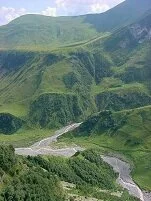Weather

Caucus Mountains
The mountains in Georgia can be cool in the spring, from March-May and fall (autumn), from September-November. They can also be snowy and impassable in the winter, while summers in the mountains can have nearly perfect conditions (average about 65˚ F during the days in Kazbegi (18˚ C)).
In the lower lands, including the capital of Tbilisi summers can be very hot (average highs from June-September are about 90˚ F (30˚ C)). The Black Sea coast is more temperate, but on the hot side, particularly during summers when average temperatures are about 77˚ F (25˚ C).
Wildlife
The wildlife in Georgia is fairly diverse considering its size, but the small country moves from alpine mountains to the sub-tropical Black Sea coast giving numerous geological and meteorological variations. Among the mammals are goats, antelope, boars, bears, squirrels, and dozens of rodents among others. The lakes and rivers are full of trout while the Black Sea has many more species.
There are also numerous birds, some of which migrate through the region, but others, such as the turkey and grouse, remain in the country for much of the year.